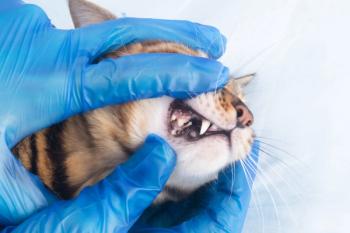
Feline urolithiasis
Could you review trends in feline urolithiasis in cats?
Q: Could you review trends in feline urolithiasis in cats?
A: Dr. Jodi L. Westropp and colleagues at the 2006 American College of Veterinary Medical Forum in Louisville, Ky., gave a lecture on trends in feline urolithiasis. Some relevant points in this lecture are provided below.
This article presents trends for feline struvite and calcium oxalate (CaOx) containing uroliths during the past 23 years, which were compiled using data from the Dr. Gerald V. Ling Urinary Stone Analysis Laboratory.
Struvite and calcium oxalate urolithiasis
Struvite- and CaOx-containing uroliths are still the most common stones analyzed by this laboratory. Struvite, also referred to as magnesium ammonium phosphate (MAP), was the predominant stone type evaluated at the laboratory until 1993. About 90 percent of struvite-containing uroliths were removed from the urinary bladder and less than 0.35 percent of the samples were submitted from the upper urinary tract. Breed predilections for feline struvite urolithiasis from the Minnesota Urolith Center include the Foreign Shorthair, Ragdoll, Chartreux, Oriental Shorthair, Domestic Shorthair and Himalayan. The Rex, Burmese, Abyssinian, Russian Blue, Birman, Siamese and mixed-breed cats had a significantly lower risk of developing struvite uroliths. At the California laboratory, Himalayan and Persian cats had a higher risk for struvite stones compared with their expected breed frequency. In cats, struvite stones usually form in sterile urine, whereas more than 90 percent of dogs, struvite stones are usually associated with a urease-producing bacterial infection. Struvite solubility is reduced in urine of pH greater than 6.7.
There has been a change in feline urolithiasis trends beginning in 1993, when 53 percent of the stones contained CaOx, while only 47 percent contained struvite. CaOx-containing uroliths continued to increase over the next eight years, while the struvite-containing uroliths decreased during that same time. It is theorized that diets used to promote urine acidification may have contributed to the increase in CaOx urolithiasis. Previous studies in cats evaluating this change suggested that breed, age, sex or reproductive status did not contribute to the apparent reciprocal relationship between the prevalence of CaOx and struvite uroliths in cats during the past 17 years. When evaluating the most recent data at University of California- Davis, it appears that another change in the urolithiasis trend may be taking place. When evaluating the past three years of data, struvite-containing stones were increasing slightly and CaOx-containing stones were decreasing slightly.
While there are several factors that could be contributing to this observed increase in struvite-containing stones, it is possible that the changes in formulation of adult maintenance feline diets to minimize the occurrence CaOx uroliths and/or a decreased use of highly acidifying diets may be influencing the composition of the stones recently submitted from cats. Further data collection will determine whether this trend continues.
In addition to struvite urolith formation, Himalayan and Persian cats also have a higher risk for CaOx as compared with their expected breed frequency. In regard to gender, more CaOx-containing stones than struvite containing stones are from male cats. The Minnesota Urolith Center reports that male cats are 1.5 times more likely to develop CaOx uroliths than female cats. CaOx urolithiasis occurs more often in older cats compared wih struvite urolithiasis, which occurs in younger cats. As CaOx-containing uroliths increased in the mid-1990s, an increasing number of CaOx-containing stones submitted to the laboratory were removed from the upper urinary tract. Ureterolithiasis in cats has become an emerging and oftentimes difficult disease for veterinarians to manage.
The pathogenesis of CaOx urolithiasis in cats is poorly understood. Animal-related factors should be addressed initially to ascertain that no intrinsic predisposing problems are present. If serum calcium concentration is elevated, a search should be initiated for underlying causes such as primary hyperparathyroidism, neoplastic processes, renal secondary hyperparathyroidism and idiopathic hypercalcemia in cats. The primary site of CaOx urolithiasis may be unrelated to urinary stasis, infection or other secondary causes for urinary stones. No studies investigating these disorders or hypotheses have been published in cats and dogs and what, if any, relationships can be made between these species remains to be seen.
Dried solidified blood calculi
Another reported stone type called dried solidified blood calculi (DSB) has been identified only in cats. DSB calculi are submitted to the California laboratory and are reported to occur in various places in the urinary tract, including the upper urinary tract. These DSB calculi are very firm and stone-like but usually do not contain crystalline material. The incidence of DSB calculi in cats seems to be increasing. These calculi are a particular diagnostic challenge. Many of these calculi were not radio-opaque unless they contained a significant portion of CaOx, calcium phosphate or other radiodense mineral. Furthermore, they often are not identified on ultrasonographic examination. If a veterinarian suspects a case, the potential DSB calculi should be submitted both in formalin and without formalin. The calculi submitted in formalin would be used for histopathological studies.
Urate urolithiasis
After CaOx- and struvite-containing uroliths, urate uroliths appear to be the third most-common mineral type submitted to the California laboratory. Although fluctuations in the percentage of struvite and CaOx-containing uroliths have occurred during the past 20 years, the same does not appear to be true for urate uroliths. No differences in gender are found in cats with urate urolithiasis (49 percent females and 51 percent males). Anecdotally, most of these cats did not have any liver disorders. Further data is needed to help elucidate the pathogenesis of urate urolithiasis in cats.
Collection and submission
Whenever a stone is obtained from an animal (either surgically, catheter-assisted, voided or by lithotripsy), it is important to submit for crystallographic analysis in order to properly identify the minerals present. Evaluating trends in feline urolithiasis is important because it may assist veterinarians in determining what, if any, effect current stone prevention strategies, including dietary modifications and drug therapy, are having in cats with urolithiasis. For more information contact the UC-Davis Stone Analysis Laboratory at
Dr. Hoskins is owner of DocuTech Services. He is a diplomate of the American College of Veterinary Internal Medicine with specialities in small animal pediatrics. He can be reached at (225) 955-3252, fax: (214) 242-2200, or e-mail:
Newsletter
From exam room tips to practice management insights, get trusted veterinary news delivered straight to your inbox—subscribe to dvm360.



